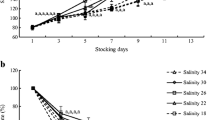Abstract
Sakura shrimp Lucensosergia lucens are pelagic shrimp that reside in the North Pacific Ocean. In Japan, commercial fishing activities aimed at this shrimp species only occurs in Suruga Bay in Shizuoka prefecture, but there has been a dramatic decrease in the magnitude of the harvest in recent years. Because sakura shrimp reside in the deep sea, their food habits and feeding behaviors are not well understood. The objective of this study was to establish a method for efficiently raising sakura shrimp larvae to juvenile shrimp. When a newly hatched larva was cultured individually, it developed to the post-larval stage when fed a sufficient amount. However, when ten individuals were cultured together, the survival rate sharply declined after 10 days owing to the cannibalism by elaphocaris III-stage larvae. This cannibalism was not due to the shortage of food because the cannibalism rate significantly dropped when larvae density was decreased to less than 1 individual/mL. The longest lifespan of a larva was 97 days, which is the longest recorded time for a sakura shrimp larval culture. Our results suggested that sakura shrimp larvae can develop to the post-larval stage in a laboratory-scale culture if the expression of cannibalism is inhibited by decreasing the larva density.






Similar content being viewed by others
Availability of data and materials
All data that supports the findings of this study is available within the article and supplementary materials.
References
Bopp L, Monfray P, Aumont O, Dufresne JL, Treut HL, Madec G, Terray L, Orr JC (2001) Potential impact of climate change on marine export production. Global Biogeochem Cycles 15:81–99
Boyd PW, Doney SC (2002) Modelling regional responses by marine pelagic ecosystems to global climate change. Geophys Res Lett. 29(16):53-1-53-4. https://doi.org/10.1029/2001GL014130
Hirata H (1975) An introduction to the rearing methods of prawn, Penaeus japonicus Bate, in Japan. Mem Fac Fish Kagoshima Univ 24:7–12
Hudinaga M, Miyamura M (1962) Breeding of the kuruma prawn, (Penaeus japonicus Bate). J Oceanogr Soc Japan 20 Anniv Vol:694–706
International Panel on Climate Control (IPCC) (2023) Climate change 2023: synthesis report. Contribution of working groups I, II and III to the sixth assessment report of the intergovernmental panel on climate change. IPCC, Geneva. https://doi.org/10.59327/IPCC/AR6-9789291691647
Jiang S, Zhou FL, Zeng XY, Yanf QB, Huang JH, Yand LS, Jiang SG (2001) Effects of four factors on Penaeus monodon post-larvae cannibalism. Iran J Fish Sci 20:547–557
Kaka RM, Jung’a JO, Badamana M, Ruwa RK, Karisa HC, (2019) Morphometric variations among populations of the wild Penaeid shrimps in Malindi-Ungwana Bay along the Northern Coast of Kenya. Int J Aquac Fishery Sci 2:155–164
Kondo M, Ohtaki T, Kubota H (1988) Rearing of the larvae of Sergia lucens with special reference to the development of nauplius stages. Bull Plankton Soc Jpn 35:75–81
Makita M, Kondo M (1982) Rearing of the larvae of Sergia lucens (Hansen). Bull Shizuoka Pref Fish Exp Stn 16:97–105
Omori M (1969) The biology of a sergested shrimp Sergested lucens Hansen. Bull Ocean Res Inst Univ Tokyo 4:1–83
Omori M (1971) Preliminary rearing experiments on the larvae of Sergestes lucens (Penaeidae, Natantia, Decapoda). Mar Biol 9:228–234
Omori M, Hashimoto J (2020) New record of Lucensosergia lucens (Hansen, 1922) in the water off Nagasaki, western Japan. Plankton Benthos Res 15:55–57
Omori M, Makita M (1976) Fishery statics of Sergia lucens in Suruga Bay. Bull Plankton Soc Jpn 23:107–113
Omori M, Ohta S (1981) The use of underwater camera in studies of vertical distribution and swimming behaviour of a sergestid shrimp, Sergia lucens. J Plankton Res 3:107–121
Omori M, Seino Y (1993) Feeding preference of the hairtail Trichilurus lepturus Linnaeus in and neighbouring the waters where Srgia lucens swarms in Suruga Bay. Bull Jpn Soc Fish Oceanogr 57:15–23
Omori M(1973) History and present status of the fishery of Sergestes lucens (Penaeida, Decapoda, Crustacea) in Suruga Bay, Japan. J Nons Int Explor Mer 35:61–77
Plattner GK, Joos F, Stocker TF, Marchal O (2001) Feedback mechanisms and sensitivities of ocean carbon uptake under global warming. Tellus Ser B 53:564–592
Qiu B, Chen S, Oka E (2023) Why did the 2017 Kuroshio Large Meander event become the longest in the past 70 years? Geophys Res Lett 50:e2023GL103548. https://doi.org/10.1029/2023GL103548
Riebesell U, Kortzinger A, Oschlies A (2009) Sensitivities of marine carbon fluxes to ocean change. Proc Natl Acad Sci USA 106:20602–20609
Wu JL, Namikoshi A, Nishizawa T, Mushiake K, Teruya K, Muroga K (2001) Effects of shrimp density on transmission of penaeid acute viremia in Panaeus japonicus by cannibalism and the waterborne route. Dis Aquat Org 47:129–135
Acknowledgements
This study was financially supported by Shizuoka prefecture through The Promotion of R&D and Industrial Application (“Seeds” Creation Research) programme (to TS).
Author information
Authors and Affiliations
Corresponding author
Ethics declarations
Conflict of interest
The authors declare no conflicts of interest.
Additional information
Publisher's Note
Springer Nature remains neutral with regard to jurisdictional claims in published maps and institutional affiliations.
Supplementary Information
Cannibalism by elaphocaris-III larva. Twenty larvae were cultured in 5 mL of DSW, and 200 μL of food was provided. The movie was captured at 11 days of culture. (MP4 3543 KB)
Rights and permissions
Springer Nature or its licensor (e.g. a society or other partner) holds exclusive rights to this article under a publishing agreement with the author(s) or other rightsholder(s); author self-archiving of the accepted manuscript version of this article is solely governed by the terms of such publishing agreement and applicable law.
About this article
Cite this article
Masuda, K., Matsuzaki, M., Suzuki, T. et al. An efficient method for raising larvae of sakura shrimp Lucensosergia lucens to the post-larva stage. Fish Sci (2024). https://doi.org/10.1007/s12562-024-01778-x
Received:
Accepted:
Published:
DOI: https://doi.org/10.1007/s12562-024-01778-x




